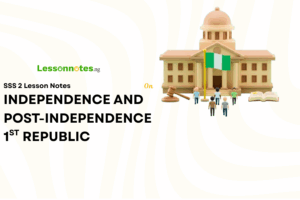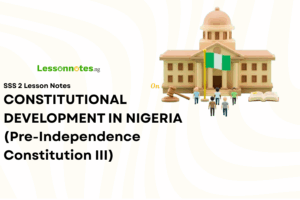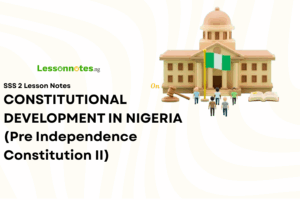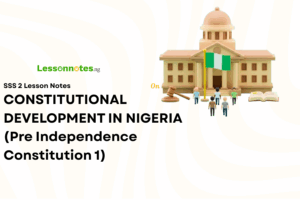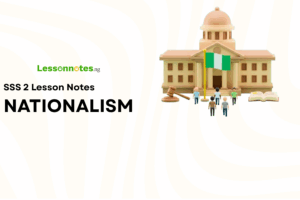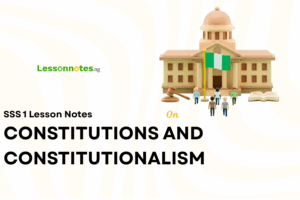Independence And Post Independence Constitution 2nd Republic SS2 Government Lesson Note
Download Lesson NoteTopic: Independence And Post Independence Constitution 2nd Republic
THE SECOND REPUBLICAN CONSTITUTION OF 1979
Historical Background
General Murtala Mohammed came to power in 1975 and he promised to return the country to civil rule after long years of military rule that started on January 15, 1966. But General Mohammed did not live to fulfil his promise. It was his deputy Lt. General Olusegun Obasanjo who made the promise a reality. This started with the establishment in 1975 of the Constitution Drafting Committee consisting of 49 members.
The Main Features Of The Second Republican Constitution Of 1979
i. The constitution rejected the Parliamentary System and introduced the Presidential System.
ii. It was headed by an executive president who acted as both the head of state and head of government.
iii. The president was directly elected by the electorate in a general election.
iv. The president appointed his ministers outside the legislature subject to confirmation by the senate.
v. The president and the vice can be removed from office by impeachment.
vi. There was the principle of separation of powers among the three organs of government.
vii. A governor who acted as the chief executive with a Deputy Governor with other members of the executive appointed by the governor called Commissioners existed in each state of the federation.
viii. The president and the governors were to hold office for four years of not more than two terms if re-laced.
ix. The president was also made the Commander in Chief of the Armed Forces.
x. Lobbying was also allowed why carpet crossing was disallowed?
xi. The judiciary was empowered by the Constitution to interpret the law.
xii. The National Assembly was bicameral which consisted of the Senate and House of Representatives.
Advantages/merits Of The 1979 Constitution
i. Separation of Power: There is separation of powers as members of the executive are not members of the legislature.
ii. The executive president was popularly elected: The president is above his political parties since he is popularly elected by the electorates and he is responsible to the electorates.
iii. Fixed Term of Office: It fixed the tenure of office of the political office holders thus; it prevents the tendency of any leader or party from perpetuating itself in power.
iv. Supremacy of the Constitution: The Constitution was supreme and as such must be obeyed and respected by all authorities and citizens.
v. Rights of Individuals: Fundamental human rights were fully elaborated and guaranteed.
vi. A new Federal Capital Territory was provided for by the constitution.
vii. The president had a free hand when selecting his ministers and as such the best materials were made by ministers.
viii. Activities of the Ministers: The president appoints his ministers. He can direct and check their activities as they are individually responsible to him.
Disadvantages/demerits Of The 1979 Constitution
i. The constitution is expensive to operate as functions are duplicated.
ii. Impeachment clause: The lawmakers can use the impeachment clause indiscriminately and victimize a political opponent.
Concentration of powers: There is the concentration of powers in the hands of the president since he combines the functions of the head of state and government.
iii. Delay in the execution of programmes: Due to separation of powers, there can be delays in the execution of government programmes.
iv. Federal Character: The appointment of people into federal establishment may not reflect federal character. This is because some sections of the country would still feel neglected.
v. Problems: There is the possibility of problems coming up between the executive and the legislature especially where the ruling party is not maintaining the majority in the legislature.
DIFFERENCES BETWEEN THE 1963 AND 1979 CONSTITUTION
- The 1963 Constitution was based on the British Parliamentary System of Government while the 1979 Constitution was based on the American form of presidential system of government.
- In the 1963 Constitution, the Prime Minister was the head of government while in the case of the 1979 Constitution, the executive president was both the head of state and head of government.
- In the 1963 Constitution, the prime minister was the leader of the party that won the majority of seats in parliament while in the 1979 constitution, the president might not be from the party that won the majority seats in parliament.
- The 1979 Constitution provided for a clear separation of powers between the executive and the legislature while the 1963 Constitution fused the two organs of government.
- The 1963 Constitution only allowed the prime minister to appoint his ministers from his party members in the parliament while in the 1979 Constitution, the president appointed his ministers outside the party.
- In the 1963 Constitution, a minister was a member of the parliament as well as the executive while in the 1979 Constitution, a minister was not a member of parliament, he belonged only to the executive arm of government.
- While the 1963 Constitution provided for the official opposition, the 1979 Constitution did not recognize official opposition.
- The 1979 Constitution did not allow the system of collective responsibility as provided in the 1963 constitution.
- In the 1963 Constitution, there was parliamentary supremacy while in the 1979 Constitution; the constitution was supreme.
- The 1979 Constitution provided that the president could be removed from office through impeachment, while the 1963 Constitution provided.






